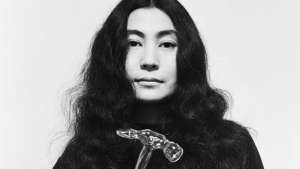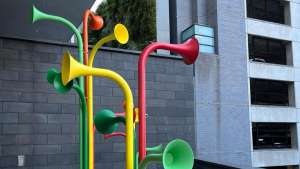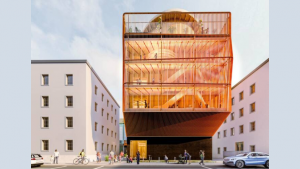“Shiny Gold”, an immersive installation at La Gaîté Lyrique in Paris that runs until November, connects visitors to energy sources, from earthquakes and the sun’s rays to Marie Curie’s discovery of radium. Tour de Moon, a recent festival for young people held in the UK, allowed participants to DJ to recordings straight from the moon, engage in interactive experiments, and play in a giant inflatable playground. The common denominator behind these experiences? French designer, artist, filmmaker and science geek Nelly Ben Hayoun.
Ben Hayoun, who holds a PhD in human geography and political philosophy, engages in ‘extreme’ fieldwork when designing experiences for organisations as diverse as the Search for Extraterrestrial Intelligence (SETI) Institute and WeTransfer.
Collaborating with a vast array of creative and intellectual talents, from NASA scientists and philosopher Noam Chomsky to the Russian band Pussy Riot and rapper Kid Cudi, Ben Hayoun likes “designing the impossible”, creating mind-expanding, multi-dimensional projects at the intersection of theatre, politics, semiotics, technology and critical design. She also founded the tuition-free postgraduate and transnational University of the Underground, based in the basement of nightclubs, and teaches Design of Experiences, using event, design and political theory as a means to challenge power structures inside and out of institutions.
Design Indaba asked her about the design processes, her fascination with science, and what design means to her.
1. Why bring design and science together – what's the dream behind your extravagant installations?
Science and some of the most incredible experiments this earth has to offer (like the Large Hadron Collider, the Super-Kamiokande neutrino detector and many others) are often for only a few of us, so the main question in my installations is how to make science more accessible. How can we all access the sublime that science can unravel? How can we trigger curiosity so that you, as a member of the public, can understand the ecosystem of which we’re a part?
I work a lot with scientists, and I understand that everything we do on a micro-scale has impact on the macro-scale – I like to bring those scales together into an experience, so that anyone can become an astronaut in their living room, or make dark energy in their kitchen sink. If we get to understand we’re a tiny part of the universe, we’d fight less about territories as we get confronted with the fact that it is not worth it given the scale of things at play in the universe. I'd like to help people understand they’re part of something much bigger.
2. Please tell us a bit about your design process and how you create what are almost imaginary worlds for visitors to enjoy.
My work always starts with a drawing or painting. I trained in textile design, so I bring together colour palettes and textures in a way that will make an experience unique to the public. I then converse with the multidisciplinary team I’m working with – for “Shiny Gold”, I worked with the Marie Curie Museum and the archive where Curie’s diary is kept, and I’ve also worked with participle physicists at CERN or scientists at the SETI Institute.
For the installations themselves, I focus on finding the right flooring and carpeting, and how I can work within a particular space – what are the pros and cons, and how can I create an immersive feeling in a small space where inflatables take up a lot of space. I work with spatial designers to create a flooring plan for the technical team to build an experience from my drawings and initial intention.
3. Tell us about your interest in heavenly bodies (the sun and the moon) and how they anchor your fascination for the world – and the universe – in which we live.
I like to focus on the sun, the moon, the multiverse… The universe is in permanent expansion and we’re only a tiny part of that. I’m fascinated by this, and I know there’s a lot to discover. The Universe is filled with dark energy but we don’t know what it is; we don’t know much really about black holes or wormholes. The greatest excitement in my lifetime would be if we can find other alien intelligence and civilisations out there. My work reminds me to stay curious about my environment. Everything in our day-to-day environment is somewhat related to another part of the cosmos and its history, this grand scale which we’re a tiny (micro) part of.
4. What does design mean to you?
I wrote my PhD on designing experiences and my practice allows for critical reflection, political shifts and decision-making processes in the context of different institutions. For me design is closely intertwined with political theory, theatre, plurality, dramaturgy. Events must allow for shifts in power and must question our potential futures. You can enjoy the experiences but you can also read them from political, theoretical or scientific angles – there are various layers of understanding and disciplines that can be brought together to build new ecosystems of knowledge. Ultimately, if you leave an experience thinking the same way you did when you entered, I have failed.
Hayoun is currently working on the development and production of a new feature-length documentary called “Red Moon”, supported by Sundance Institute as a part of Sandbox Films for release in 2023.
You can explore Hayoun’s brain on WorldwideFM as a part of her radio show – the Nelly Boum Show – bringing together a plurality of voices from Algeria, Armenia and their diasporas over the world.
Read more:
Experience designer Nelly Ben Hayoun on colonising Mars with the worms from hell.
Credits: Nick Ballon









